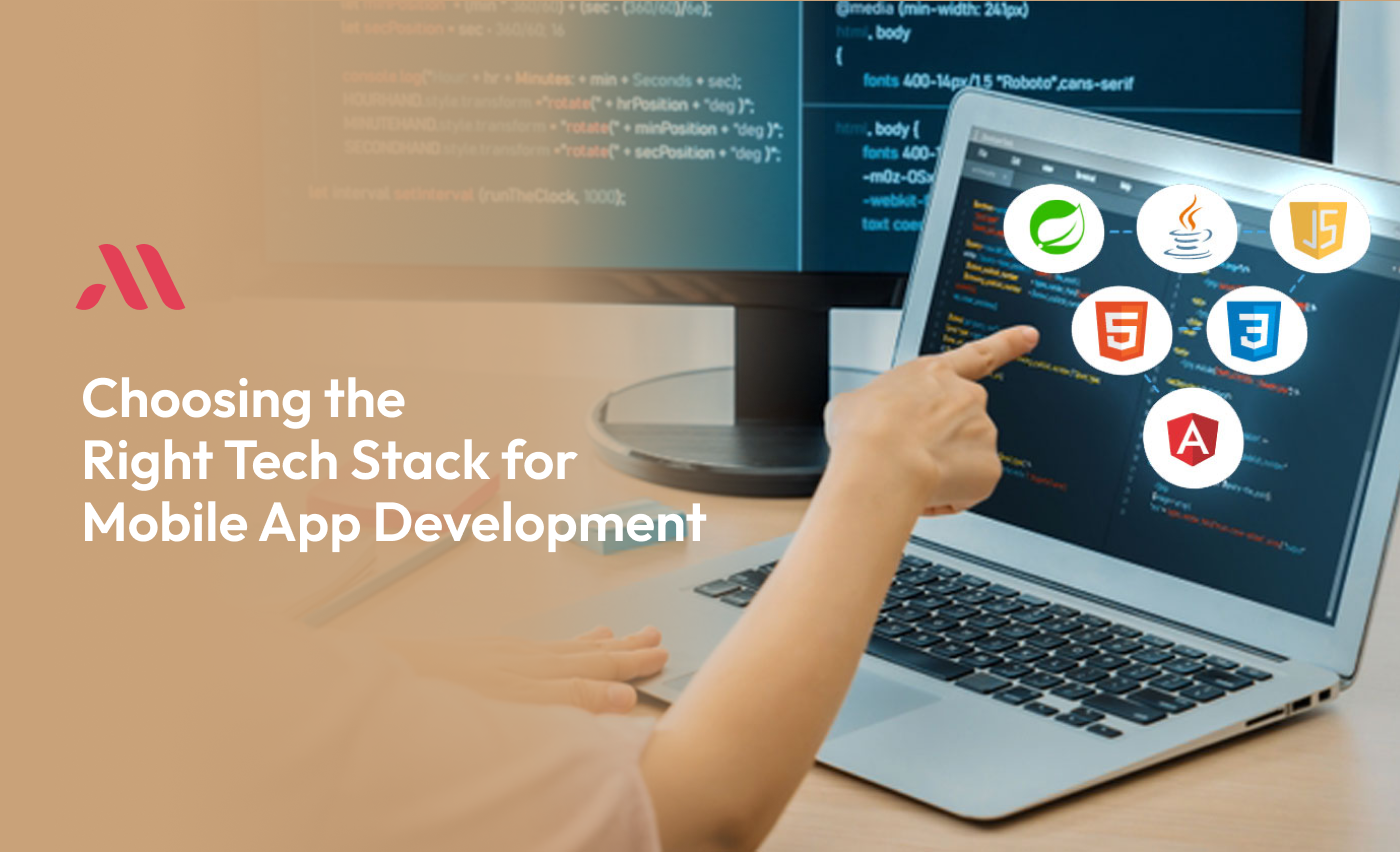Choosing the right tech stack for app development is like picking the best tools for building a house. You must select the right materials and tools to create a strong and beautiful home. Similarly, for a mobile app, you need the best tech stack to make sure your app is fast, reliable, and happy to use. But what is a tech stack? Let's find out!
What is a Tech Stack?
A tech stack combines programming languages, frameworks, and tools developers use to create a mobile app. Think of it as the ingredients you need to bake a cake. Each ingredient has a specific role, and together they make a delicious cake. In the same way, each part of a tech stack has a role in building a great app.
Why is Choosing the Right Tech Stack Important?
Choosing the right tech stack is most important for app development. Here are a few reasons why:
- Performance: The right tech stack ensures your app runs smoothly and quickly.
- Scalability: A good tech stack helps your app to grow and handle more users without crashing.
- Development Speed: Some tech stacks make it easier and faster to build your app.
- Maintenance: A good tech stack makes it easier to fix bugs and add new features.
The Parts of a Tech Stack
A tech stack has two main parts: the front-end and the back-end.
Front-End
The front-end is what users see and interact with on their screens. It includes:
- Languages: HTML, CSS, JavaScript
- Frameworks: React Native, Flutter, Swift (for iOS), Kotlin (for Android)
Back-End
The back-end is like the engine of a car. It's the part that users don't see but makes everything work. It includes:
- Languages: Python, Java, Node.js
- Frameworks: Django, Spring, Express
- Databases: MySQL, MongoDB, PostgreSQL
How to Choose the Right Tech Stack
Now, let's talk about how to choose the right tech stack for your app development. Here are some tips to help you decide.
1. Understand Your App Requirements
First, you need to know what your app needs. Is it a game, a shopping app, or a social media app? Different apps have different needs. For example, a game needs to be fast and responsive, so you might choose a tech stack that is great for performance.
2. Consider Your Budget
Some tech stacks can be expensive. If you're on a tight budget, you may want to choose a tech stack that is free or low-cost. Open-source tech stacks, like React Native and Node.js, are great options because they are free to use.
3. Think About Your Team's Skills
If your team is already good at certain languages or frameworks, it makes sense to use those in your tech stack. For example, if your team knows JavaScript, you might choose a tech stack that uses React Native for the front-end and Node.js for the back-end.
4. Look at the Community Support
It's always helpful to choose a tech stack with a large and active community. This way, if you have a problem, you can find lots of tutorials, forums, and documentation to help you out. Popular tech stacks like React Native, Flutter, and Node.js have big communities.
5. Check for Scalability
If you plan to grow your app to have millions of users, you need a tech stack that can handle a lot of traffic. Look for tech stacks that are known for their scalability, like Django for the back-end and Flutter for the front-end.
6. Look at Security
Security is very important for app development. Make sure the tech stack you choose has strong security features to protect your app and its users. Frameworks like Django and Spring are known for their security features.
Examples of Popular Tech Stacks for App Development
Here are some of the most popular tech stacks used in app development:
1. React Native + Node.js
- Front-End: React Native
- Back-End: Node.js
- Database: MongoDB or PostgreSQL
This tech stack is great for building cross-platform apps that work on both iOS and Android. React Native allows you to write one set of code and use it for both platforms, which saves time and effort.
2. Flutter + Firebase
- Front-End: Flutter
- Back-End: Firebase (a Backend-as-a-Service platform)
Flutter is another great option for cross-platform development. It's known for its beautiful and customizable UI components. Firebase handles all the back-end services, like authentication, database, and cloud storage, making it easier to develop and manage your app.
3. Swift + Node.js
- Front-End: Swift (for iOS)
- Back-End: Node.js
- Database: MongoDB
This tech stack is perfect for building high-performance iOS apps. Swift is the preferred language for iOS development, and Node.js is a powerful and flexible back-end option.
4. Kotlin + Spring Boot
- Front-End: Kotlin (for Android)
- Back-End: Spring Boot
- Database: MySQL
Kotlin is the official language for Android app development. Paired with Spring Boot, a powerful back-end framework, this tech stack is great for building robust and scalable Android apps.
Kotlin is the official language for Android app development. Paired with Spring Boot, a powerful back-end framework, this tech stack is great for building robust and scalable Android apps.
A Detailed Study of Tech Stack Components
1. Front-End Frameworks
Let's get some info on some popular front-end frameworks used in app development:
React Native
React Native is a popular choice for building cross-platform mobile apps. Developed by Facebook, it allows developers to use JavaScript and React to create apps for both iOS and Android. With React Native, you can write code once and deploy it on multiple platforms, saving time and effort.
Benefits of React Native:
- Code Reusability: Write code once and use it on both iOS and Android.
- Large Community: Access to a vast community of developers for support and resources.
- Fast Development: Speeds up development with reusable components and libraries.
Flutter
Flutter, created by Google, is another excellent framework for cross-platform development. It uses the Dart programming language and provides a rich set of customizable widgets for building beautiful and responsive UIs.
Benefits of Flutter:
- Hot Reload: Instantly see changes in your app without restarting it.
- Expressive UIs: Create stunning user interfaces with customizable widgets.
- Strong Performance: Delivers smooth and fast performance on both iOS and Android.
2. Back-End Frameworks
Now, let's explore some popular back-end frameworks used in app development:
Node.js
Node.js is a powerful and flexible back-end framework that uses JavaScript. It is known for its speed and efficiency, making it a popular choice for building scalable and high-performance apps.
Benefits of Node.js:
- Non-Blocking I/O: Handles multiple requests at the same time without blocking the server.
- Large Ecosystem: Get a vast library of packages and modules through npm (Node Package Manager).
- Scalability: Easily scales to handle a large number of users and high traffic.
Django
Django is a high-level Python framework known for its simplicity and security. It follows the "batteries-included" philosophy, providing everything you need to build a robust back-end.
Benefits of Django:
- Rapid Development: Built-in tools and features speed up the development process.
- Security: Strong security features protect your app from common deficiencies.
- Scalability: Easily handles high traffic and large amounts of data.
Future Trends in Tech Stacks
1. Artificial Intelligence and Machine Learning
Artificial Intelligence (AI) and Machine Learning (ML) are becoming important in app development. Integrating AI and ML capabilities into your app can provide customized user experiences and intelligent features.
Popular AI/ML Tools:
- TensorFlow: An open-source ML framework by Google.
- Core ML: Apple's framework for integrating ML models into iOS apps.
2. Internet of Things (IoT)
The Internet of Things (IoT) is another growing trend in app development. IoT apps connect and control smart devices, providing users with advanced functionalities and automation.
Popular IoT Tools:
- IoT Core: Google's platform for building IoT applications.
- AWS IoT: Amazon's platform for connecting IoT devices and applications.
3. Augmented Reality (AR) and Virtual Reality (VR)
AR and VR are changing the way we interact with apps. Integrating AR and VR into your app can create immersive and engaging experiences for users.
Popular AR/VR Tools:
- ARKit: Apple's framework for building AR experiences on iOS.
- ARCore: Google's platform for creating AR experiences on Android.
Conclusion
Choosing the right tech stack for app development is Important for the success of your mobile app. By understanding your app's requirements, considering your budget, thinking about your team's skills, looking at community support, checking for scalability, and evaluating security, you can make the best decision.
Remember, there is no one-size-fits-all solution. The best tech stack for your app depends on your specific needs and goals. Whether you choose React Native, Flutter, Swift, Kotlin, or any other combination, make sure it aligns with your vision for your app.
Happy app developing!
Ready to build your dream app? Choose MicraSol for expert mobile app development services today!
FAQS
1. What is a tech stack in app development?
A tech stack in app development combines programming languages, frameworks, and tools used to build a mobile app. It includes both front-end and back-end technologies that work together to create a functional and high-performing application.
2. Why is choosing the right tech stack important for app development?
Choosing the right tech stack is important because it affects the app's performance, scalability, development speed, and maintenance. A well-chosen tech stack ensures your app runs smoothly, can grow with more users, and is easier to develop and maintain.
3. How does the tech stack affect app performance?
The tech stack directly impacts app performance. Efficient technologies ensure that the app runs quickly and smoothly, providing a better user experience. Choosing high-performing languages, frameworks, and databases is important for maximum app performance.
4. Can I change the tech stack after starting the development?
Changing the tech stack after starting development is possible but can be challenging and costly. It's important to carefully choose the right tech stack from the beginning to avoid many changes later on. However, some modular and flexible architectures can make transitions smoother.
5. What role does community support play in choosing a tech stack?
Community support is important as it provides access to tutorials, documentation, forums, and shared knowledge. A large and active community can help resolve issues faster and offer best practices, making development smoother and more efficient.








